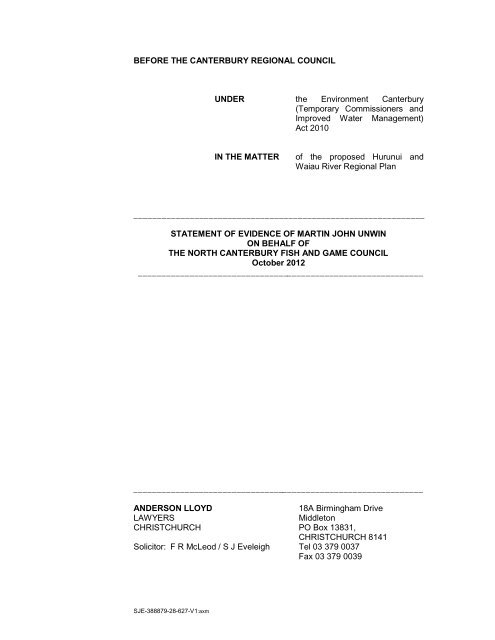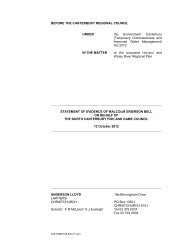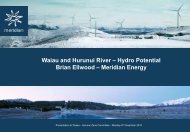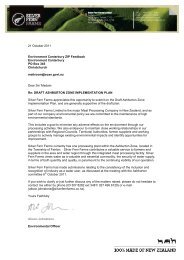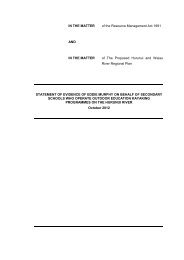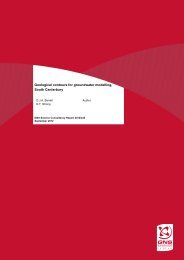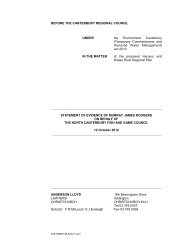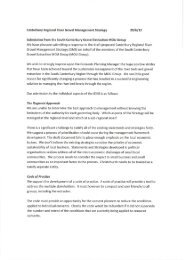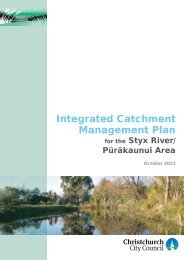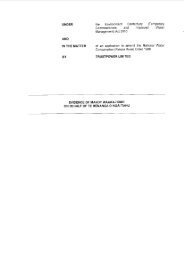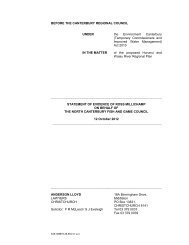Evidence of Martin Unwin - Environment Canterbury
Evidence of Martin Unwin - Environment Canterbury
Evidence of Martin Unwin - Environment Canterbury
You also want an ePaper? Increase the reach of your titles
YUMPU automatically turns print PDFs into web optimized ePapers that Google loves.
BEFORE THE CANTERBURY REGIONAL COUNCILUNDER the <strong>Environment</strong> <strong>Canterbury</strong>(Temporary Commissioners andImproved Water Management)Act 2010IN THE MATTER<strong>of</strong> the proposed Hurunui andWaiau River Regional Plan______________________________________________________________STATEMENT OF EVIDENCE OF MARTIN JOHN UNWINON BEHALF OFTHE NORTH CANTERBURY FISH AND GAME COUNCILOctober 2012___________________________________________________________________________________________________________________________ANDERSON LLOYDLAWYERSCHRISTCHURCHSolicitor: F R McLeod / S J Eveleigh18A Birmingham DriveMiddletonPO Box 13831,CHRISTCHURCH 8141Tel 03 379 0037Fax 03 379 0039SJE-388879-28-627-V1:axm
21. INTRODUCTIONQualifications and Experience1.1 My name is <strong>Martin</strong> John <strong>Unwin</strong>. I hold the qualification <strong>of</strong> Master <strong>of</strong>Science in Physics (with Distinction) from the University <strong>of</strong> <strong>Canterbury</strong>.I am a member <strong>of</strong> the American Fisheries Society and the GilbertIchthyological Society, and have recently completed a five year termon the Editorial Advisory Board <strong>of</strong> the New Zealand Journal <strong>of</strong> Marineand Freshwater Research, published by the Royal Society <strong>of</strong> NewZealand.1.2 I have been employed by the National Institute <strong>of</strong> Water andAtmospheric Research and its predecessor organisations for 34 years,and am currently a Senior Fisheries Scientist. My main researchinterest has been the biology <strong>of</strong> Chinook salmon in New Zealandwaters, a topic on which I have published over thirty papers in thirteenpeer-reviewed international scientific journals.1.3 A strong secondary interest throughout my research career has beencollecting and analysing data on usage <strong>of</strong> New Zealand’s fisheryresources by recreational anglers. I have helped design and analysenumerous surveys <strong>of</strong> recreational fisheries in both marine andfreshwater environments, and have authored or co-authored over thirtyreports on the results.1.4 I have been engaged by North <strong>Canterbury</strong> Fish and Game Council(F&G) to prepare evidence in relation to the Hurunui and Waiau RiverRegional Plan. I previously presented evidence at the SpecialTribunal hearing in relation to a Water Conservation Order on theHurunui River. I am well familiar with the Hurunui and Waiaucatchments through my pr<strong>of</strong>essional interest in Chinook salmonbiology and angling demographics; a lifelong association with theSouth Island high country; and recreational activities includingtramping, white water kayaking, and mountain biking.SJE-388879-28-627-V1:axm
42.2 The upper Hurunui River sustains a highly valued back country troutfishery, allowing anglers to employ a diverse range <strong>of</strong> fishing methodsin a remote and scenic landscape, frequently in association with otheroutdoor recreational activities such as camping, picnicking, andtramping.2.3 Four upper Waiau River tributaries – the Hope River, Boyle River,Nina River, and Lewis River – sustain headwater trout fisheries withattributes typical <strong>of</strong> highly valued wilderness fisheries elsewhere inNew Zealand. These fisheries are <strong>of</strong> regional or local significance.2.4 Annual usage <strong>of</strong> the upper Hurunui River in 2007/08 wasapproximately 5 500 ± 1 000 angler-days. This figure is high comparedto other fisheries <strong>of</strong> similar type, only three <strong>of</strong> which - the upper Oreti,Tekapo, and Ahuriri Rivers – sustain equal or greater levels <strong>of</strong> annualusage.2.5 Most anglers fishing the upper Hurunui River hold licences from theNorth <strong>Canterbury</strong> F&G region. Visitors from other regions and fromoverseas accounting for a relatively low proportion <strong>of</strong> total usage.2.6 The upper Hurunui receives more visits from New Zealand residentanglers than any other back country fishery. This is in contrast to theupper Oreti, Tekapo, Ahuriri, and upper Buller Rivers, which derive37% - 58% <strong>of</strong> their usage from overseas visitors.2.7 More whole-season fishing licences are sold in North <strong>Canterbury</strong> thanin any other New Zealand region, accounting for 16% - 20% <strong>of</strong> F&Gsales. The corresponding figure for the whole <strong>of</strong> <strong>Canterbury</strong>, includingthe Central South Island F&G region, is 25% - 32%.2.8 The Hurunui River sustains a regionally significant salmon fishery, andthe Waiau River sustains a locally significant salmon fishery.SJE-388879-28-627-V1:axm
5Maintenance <strong>of</strong> both fisheries is dependent on adult and juvenilesalmon having unimpeded passage to and from the headwaterspawning waters.2.9 A dam on the Hurunui South Branch would result in almost certain loss<strong>of</strong> salmon spawning habitat in the upper South Branch.3. ANGLING SAMPLE SURVEYS3.1 Any person wishing to fish for salmon and trout in waters managed byF&G must purchase a fishing licence at least annually from one <strong>of</strong> thetwelve F&G regions. Because <strong>of</strong> this requirement, fishing licencedatabases are an essential tool for F&G managers seeking to collectinformation on usage <strong>of</strong> the angling resource, and are particularlysuited to sample surveys. Briefly, sample surveys involve selecting arandom sample <strong>of</strong> licence holders and administering a questionnaireto collect the information <strong>of</strong> interest. Subject to the assumption that theinformation so obtained is not significantly influenced either by licenceholders who cannot be contacted (non-response bias), or who cannotaccurately remember details such as when and where they fished(recall bias), the sample results can be extrapolated to give a resultapplicable to all licence holders.3.2 For the purposes <strong>of</strong> this hearing I provide an overview <strong>of</strong> four nationalsample surveys, undertaken on behalf <strong>of</strong> F&G, with which I have beenpersonally involved (via design, analysis, or both) over the last 30years. These took place in 1979/1981, 1994/95, 2001/02, and 2007/08(Teirney et al. 1987, Teirney et al. 1982, <strong>Unwin</strong> 2009, <strong>Unwin</strong> & Brown1998, <strong>Unwin</strong> & Image 2003). In addition, the Hurunui fishery was thesubject <strong>of</strong> three surveys <strong>of</strong> North <strong>Canterbury</strong> anglers conductedannually from 1980 to 1982 (Bonnett et al. 1991). Where relevant, myevidence also draws on these surveys.3.3 My evidence focuses on the findings <strong>of</strong> these surveys and theirrelevance to the Hurunui and Waiau Rivers, with minimal reference toSJE-388879-28-627-V1:axm
6the details <strong>of</strong> the survey methodology. Full descriptions and results forall surveys are publicly available via the reports listed in thebibliography.4. THE 1979/81 NATIONAL ANGLING SURVEY4.1 The 1979/81 National Angling Survey was developed in response tothe requirements <strong>of</strong> the 1981 Amendment to the Water and SoilConservation Act. This Amendment provided a new legislativemechanism (WCOs) for recognising and protecting rivers <strong>of</strong> nationalimportance, and created a need for consistent and objective data onangler usage <strong>of</strong> New Zealand river fisheries (National Water and SoilConservation Organisation 1982, Teirney et al. 1982).4.2 With the benefit <strong>of</strong> 30 years <strong>of</strong> hindsight, I see the main legacy <strong>of</strong> the1978/79 survey as its role in developing a consistent scheme forcharacterising individual river fisheries (Teirney et al. 1982). Under thisscheme, river fisheries fall into one <strong>of</strong> three broad groupings, definedas recreational (or lowland) fisheries; scenic (or back country)fisheries; and wilderness (or headwater) fisheries (Table 1). Thesecategories encapsulate the transition from highly accessible andheavily used fisheries close to population centres (e.g., Mataura,Rakaia, Motueka), to remote headwater fisheries in pristine wildernessenvironments (e.g., Caples, Greenstone, Sabine).4.3 A word on terminology may be helpful to the Commission at this point.Terms such as “lowland river”, “back country fishery”, “wildernessfishery”, “headwater fishery”, and “trophy fishery” have been usedfreely by a number <strong>of</strong> authors over many years and have the potentialto cause confusion. The important point is that all such terms attemptto characterise individual fisheries along a continuous spectrum,ranging from lowland rivers in highly developed catchments to pristinerivers in remote mountain valleys. It is this spectrum which isimportant, rather than any arbitrary breakpoints between different rivertypes.SJE-388879-28-627-V1:axm
75. THE 1994/96, 2001/02, AND 2007/08 NATIONAL ANGLINGSURVEYSBackground5.1 The objective <strong>of</strong> the 1994/96 - 2007/08 surveys was to obtainconsistent estimates <strong>of</strong> annual usage (during a single October toSeptember angling season) for all waters managed by F&G. The1994/95 and 2001/02 surveys were limited to New Zealand residentlicence holders, who were interviewed by telephone. The 2007/08survey also included overseas visitors, who were contacted by emaildrawn from random samples <strong>of</strong> the ~40% <strong>of</strong> visitors who provided ausable email address. Total usage estimates for the 1994/95 and2001/02 surveys are thus slightly conservative relative to those for the2007/08 survey.5.2 The basic measure <strong>of</strong> angling effort provided by the surveys is theangler-day, defined as one angler fishing on one day irrespective <strong>of</strong>the number <strong>of</strong> hours spent fishing. By summing results across allregions, the survey provides usage estimates for essentially all NewZealand angling waters. Standard errors for most waters are relativelybroad (typically ±20% - 50%) but are to be interpreted in the context <strong>of</strong>usage estimates ranging from well over 10,000 for the most heavilyfished waters (e.g., Waimakariri, Mataura) to single figures for themost remote headwater streams. For example, estimated annualusage <strong>of</strong> the Rakaia, Ashley, and Halswell Rivers in 2007/08 was53,200 ± 4,400, 5,400 ± 2,000, and 460 ± 180 angler days,respectively. These standard errors represent relative uncertainties <strong>of</strong>8%, 37%, and 39%, respectively, but do not prevent us inferring withconfidence that the Rakaia receives about 10 times as much effort asthe Ashley, and that the Ashley receives about 10 times as much effortas the Halswell.SJE-388879-28-627-V1:axm
85.3 For the 2001/02 and 2007/08 surveys, I used National Census data toestimate per capita sales <strong>of</strong> whole-season fishing licences for eachF&G region, on the assumption that 90% <strong>of</strong> anglers are male (c.f.Teirney et al. 1982). The 2001/02 data include licence sales for theTaupo Conservancy, which is administered by the Department <strong>of</strong>Conservation (and so lies outside F&G's jurisdiction), and aretherefore fully representative <strong>of</strong> all freshwater angling by New Zealandresidents. The 2007/08 data do not include licence sales for the TaupoConservancy, and are therefore conservative with respect to thenumber <strong>of</strong> anglers in the upper North Island.6. SURVEY FINDINGS1979/81 Survey: Hurunui River6.1 The Hurunui River featured prominently in the 1979/81 survey, andwas discussed extensively in two reports <strong>of</strong> which I was a co-author(Teirney et al. 1987, Teirney et al. 1982). Key findings were:a. North <strong>Canterbury</strong> anglers expended between 15 800 and 23700 angler-days per year on the Hurunui River;b. The Hurunui River was highly valued for both trout and salmonfishing, with respondents dividing their effort more or lessevenly between the two fisheries;c. The trout fishery was primarily confined to the middle andupper reaches <strong>of</strong> the river, corresponding to the sections fromSH 7 to Mandamus, and Mandamus to the headwaters,respectively;d. The upper reaches were highly rated for “scenic beauty” and“feelings <strong>of</strong> peace and solitude”, both <strong>of</strong> which were consideredexceptional by over 80% <strong>of</strong> respondents (Table 2).e. Other notable characteristics <strong>of</strong> the Hurunui trout fishery werethe diversity <strong>of</strong> angling methods it sustained (dry fly, wet fly,spinner, nymph), and the extent to which angling wasassociated with other recreational activities such as camping,picnicking, swimming, tramping, and shooting (Table 2).SJE-388879-28-627-V1:axm
96.2 Our 1982 report considered that “… the upper Hurunui has all theattributes <strong>of</strong> a nationally important river fishery” (Teirney et al. 1982).In particular, we noted that its usage (approximately 5000 visitsannually from trout anglers) was high given its remote location andlimited vehicle access. The salmon fishery in the lower reaches alsocontributed to the high importance attached to the river as a whole, butwas secondary to the headwater trout fishery.6.3 These conclusions were reinforced in our 1987 report (Teirney et al.1987), which focussed specifically on the North <strong>Canterbury</strong> region andincluded additional data which were unavailable when the 1982 reportwas published. These data, based on the 1982 survey referred to inparagraph 3.2 above (Bonnett et al. 1991), included a more detailedanalysis <strong>of</strong> the longitudinal distribution <strong>of</strong> angling effort along theHurunui River than was possible with the National Angling Survey.6.4 Respondents to the 1982 survey were asked to identify which <strong>of</strong> sevenreaches they fished, including four above the Mandamus confluence.Analysis <strong>of</strong> these responses showed that:a. The reach from Mandamus to the South Branch receivedrelatively little effort (less than ~5% <strong>of</strong> total effort, includingboth salmon and trout angling), but accounted for about 10% <strong>of</strong>the trout caught;b. The South Branch was the least fished <strong>of</strong> all seven reaches onthe river, accounting for less than 5% <strong>of</strong> total effort;c. The North Branch, (i.e., the Hurunui main stem above theSouth Branch confluence), including Lake Sumner and theheadwaters above the lake, accounted for ~25% <strong>of</strong> the totaleffort and about 60% <strong>of</strong> the trout catch. Effort and catch wereevenly divided between the reach below the lake, and the lakeand its headwaters.SJE-388879-28-627-V1:axm
106.5 One <strong>of</strong> the considerations which led us to rank the Hurunui River asnationally important was the number <strong>of</strong> anglers it attracted fromoutside the North <strong>Canterbury</strong> region. On re-analysing these data forthe purposes <strong>of</strong> this hearing, it appears that 75% (15 out <strong>of</strong> 20) <strong>of</strong>these visitors fished only for salmon, or for both salmon and trout. Only25% <strong>of</strong> visitors (5 out <strong>of</strong> 20), all <strong>of</strong> whom were from the upper SouthIsland (Marlborough and the West Coast), fished solely for trout. I willdiscuss the significance <strong>of</strong> this result in relation to my currentassessment <strong>of</strong> the upper Hurunui fishery later in this evidence.1979/81 Survey: Waiau River6.6 The Waiau is the northernmost river which sustains an establishedsalmon fishery, and was identified as regionally important in the1979/81 survey (Teirney et al. 1982). The lower and middle reaches <strong>of</strong>the mainstem support good, but not exceptional, angling for salmonand trout (Table 3), with estimated annual usage (approximately 6 500angler-days) well below that <strong>of</strong> the Hurunui. Most (69 out <strong>of</strong> 73)respondents who fished the Waiau were from the upper South Island,consistent with its regionally important classification.6.7 The most highly valued trout fisheries within the Waiau catchmentwere associated with the upper mainstem and headwater tributaries,particularly the Hope, Boyle, Nina, and Lewis Rivers. Collectively,these four tributaries support typical wilderness/headwater fisheries,characterised by high ratings for their scenic and wilderness qualities,limited access, and large fish (Table 4). The most popular lures weredry fly, nymph, and wet fly on the Hope and Boyle Rivers, and nymphsand dry flies on the smaller Lewis and Nina Rivers. However, only 2 <strong>of</strong>the 47 respondents who fished these rivers came from outside the<strong>Canterbury</strong> region, suggesting that – at least as <strong>of</strong> c. 1980 – they were<strong>of</strong> regional or local rather than national value.6.8 Four other Waiau tributaries were fished by at least one respondent,but did not attract enough effort to merit detailed consideration in theSJE-388879-28-627-V1:axm
111979/81 survey report. These were the Mason River (4 respondents);the Hanmer River (6 respondents); and the Percival and DoubtfulRivers (1 respondent each).1994/96 - 2007/08 Surveys: Hurunui River6.9 The Hurunui catchment has consistently been the third most heavilyfished catchment in the North <strong>Canterbury</strong> region (Table 5), well behindthe Waimakariri and Rakaia catchments but well ahead <strong>of</strong> the nextthree (Waiau, Ashley, and Selwyn/Ellesmere). Total angling effort in2001/02 was markedly lower than in either 1994/95 and 2007/08,reflecting the unusually poor salmon fishing season in 2002 (<strong>Unwin</strong>2009, <strong>Unwin</strong> & Brown 1998, <strong>Unwin</strong> & Image 2003).6.10 Usage <strong>of</strong> the Hurunui River main stem has varied almost two-fold overthe period <strong>of</strong> record, from 17,100 angler days in 1994/95 to 8,380angler days in 2001/02. Usage in 2007/08 was intermediate betweenthese two extremes. The main stem accounted for 90% <strong>of</strong> the effortexpended within the Hurunui catchment in 1994/95, 82% in 2001/02,and 66% in 2007/08. The relatively low figure for 2007/08 reflects anincrease in the total effort expended elsewhere in the catchment (seeparagraph 6.12), but it is unclear whether this reflects an on-goingtrend or is merely due to annual variability.6.11 The 2001/02 and 2007/08 surveys treated the Hurunui main stem astwo sections, corresponding to the reaches above and below theMandamus confluence (referred to here as the upper and lowerreaches, respectively). Based on the 72% <strong>of</strong> responses for which thisinformation was available, the upper reaches attracted 40% <strong>of</strong> theeffort expended on the Hurunui River in 2001/02, and 44% in 2007/08.Almost all <strong>of</strong> effort spent on the Hurunui River (100% and 98% in2001/02 and 2007/08, respectively) was recorded over the eightmonths from October to May.SJE-388879-28-627-V1:axm
126.12 The Hurunui catchment sustains eight recognised river and lakefisheries other than the Hurunui mainstem, all but one <strong>of</strong> which (theWaitohi River) lie upstream <strong>of</strong> the Mandamus confluence (Table 6).Collectively, these waters accounted for an estimated 1 860, 1 830,and 6 370 angler-days over the three surveys, over 99% <strong>of</strong> which wasassociated with Lake Sumner and its immediate neighbours (LakesTaylor, Sheppard, Mason, and Loch Katrine). Lakes Taylor andSumner were by far the most popular <strong>of</strong> these fisheries, jointlyattracting over 5 000 angler-days in 2007/08. All five lakesexperienced a substantial increase in usage from 2001/02 to 2007/08.6.13 The North <strong>Canterbury</strong> region accounted for 87% <strong>of</strong> the effortexpended on the Hurunui River in 2007/08, with anglers from otherNew Zealand regions accounting for 9% <strong>of</strong> the total and overseasvisitors accounting for the remaining 4% (Table 7). The spatialdistribution <strong>of</strong> effort for visiting anglers is partly confounded by effortfor which the angling location is undefined, but the available datasuggest that most <strong>of</strong> this effort is expended in the upper reaches. Ofthe effort which can be assigned to a specific reach, visiting anglersaccounted for 21% <strong>of</strong> the effort on the upper reaches, compared to2.5% on the lower reaches.1994/96 - 2007/08 Surveys: Waiau River6.14 The Waiau catchment currently (2007/08) ranks as the fourth mostheavily fished catchment in the North <strong>Canterbury</strong> region, althoughgiven the broad confidence intervals for estimated annual usage it isperhaps more prudently ranked as fourth equal with the Ashley (Table8). Its popularity appears to have increased since 1994/95, when itwas a clear sixth after the Selwyn and Ashley (Table 8).6.15 The Waiau main stem accounted for 49% <strong>of</strong> effort within the Waiaucatchment in 1994/95, and 69% in 2001/02 and 2007/08 (Table 8).Most <strong>of</strong> the remaining effort was expended on the four headwater troutfisheries identified in the 1979/81 survey, i.e., the Hope, Boyle, Nina,SJE-388879-28-627-V1:axm
13and Lewis Rivers. Collectively these four rivers accounted for 49% <strong>of</strong>the catchment total in 1984/85, 22% in 2001/02, and 25% in 2007/08.These figures are subject to considerable uncertainty, but all threesurveys suggest that the Hope River and Boyle River attract rathermore effort than either the Nina River or the Lewis River, consistentwith the findings <strong>of</strong> the 1979/81 survey.6.16 The North <strong>Canterbury</strong> region accounted for 81% <strong>of</strong> the effortexpended on these five rivers in 2007/08, with anglers from other NewZealand regions accounting for 10% <strong>of</strong> the total and overseas visitorsfor 9% (Table 9). New Zealand resident anglers from other regionstended to fish the Waiau mainstem, which accounted for 77% <strong>of</strong> visitoreffort. Half <strong>of</strong> this total (220 out <strong>of</strong> 440 angler-days) was due to anglersfrom the Nelson/Marlborough region, for whom the Waiau Riverprovides the closest fishery for sea-run salmon. By contrast, overseasvisitors were primarily attracted to the headwater tributaries,accounting for 76% <strong>of</strong> the estimated 2007/08 total for these rivers.Licence Sales and Angling Demographics6.17 Analysis <strong>of</strong> licence sales in relation to Census data shows markedvariation in the popularity <strong>of</strong> freshwater angling throughout NewZealand, and highlights four distinct regional trends (Table 10).Specifically:a. Angling is significantly more popular in the South Island than inthe North Island (participation rate 8.6% - 10.8% vs. 1.9% -2.5%);b. Participation rates for the most urbanised regions (Auckland1.0% - 1.4%, Wellington 1.7% - 2.7%) are among the lowest inthe country;c. Participation rates tend to increase from north to south,particularly in the South Island;d. More F&G whole-season licences are sold in North <strong>Canterbury</strong>than in any other region.SJE-388879-28-627-V1:axm
146.18 The North <strong>Canterbury</strong> region accounted for 16% <strong>of</strong> whole seasonlicences sold in 2001/02, and 20% <strong>of</strong> those sold in 2007/08. Includingthe Central South Island region, <strong>Canterbury</strong> accounted for 25.5% <strong>of</strong>sales in 2001/02, and 32.0% in 2007/08.6.19 Per capita licence sales in North <strong>Canterbury</strong> (5.8% - 6.6%) are higherthan for any North Island F&G region, but low compared to most otherSouth Island regions. This is consistent with the trend towardsdecreasing per capita sales in the more urban areas, and reflects therelatively low per capita rate for residents <strong>of</strong> Christchurch city. Thecorresponding figure for rural North <strong>Canterbury</strong> residents north <strong>of</strong> theWaimakariri River (i.e., Waimakariri and Hurunui Districts) was 9.4%(1 797 licences among 19 200 adult males). This is close to one out <strong>of</strong>every ten adult males, and is more consistent with the exceptionallyhigh per capita rates in the lower South Island.6.20 National variation in per capita sales <strong>of</strong> fishing licences can be partlyattributed to climatic and geographic influences, in that trout (andsalmon) are essentially cool temperate species. However, I believe theobserved trends also reflects the general tendency for angling tobecome less viable as a recreational activity as land use patternschange from extensive to intensive, and urbanisation increases. Thecurrent level <strong>of</strong> angling activity in North <strong>Canterbury</strong> can thus beinterpreted as representing an intermediate state between the morehighly urbanised areas <strong>of</strong> the North Island, and the more rural areas <strong>of</strong>the lower South Island.7. NATIONAL CONTEXTHurunui River7.1 The upper Hurunui River is one <strong>of</strong> 263 recognised back countryfisheries under F&G’s jurisdiction. Such fisheries are typically inupland regions characterised by extensive rather than intensive landSJE-388879-28-627-V1:axm
15use, and are remote from major population centres although stillaccessible by road (c.f. Table 1). The most highly valued back countryfisheries typically attract around 5 000 angler-days per year, incontrast to mainstem and lowland fisheries (some <strong>of</strong> which attract wellover 10 000 angler-days), and headwater fisheries (which rarely attractmore than 1 000 angler-days).7.2 A total <strong>of</strong> six back country river fisheries attracted more than 4 000angler-days in 2007/08: the upper Oreti, upper Hurunui, upper Taieri,Ahuriri, Tekapo, and Waikaia (Table 11) 1 . Two <strong>of</strong> these rivers (theAhuriri and upper Oreti) are subject to WCOs. I have also tabulatedusage estimates for the upper Buller River. Estimated usage <strong>of</strong> theBuller River by New Zealand resident anglers in 2007/08 (2 640angler-days) was low compared to previous seasons (5 060 and 4 310angler-days in 1994/95 and 2001/02, respectively), but as a backcountry fishery covered by a WCO the upper Buller River provides afurther basis for comparison.7.3 Adjusted 2007/08 usage estimates for the top six rivers listed in Table11 range from 6 790 angler-days for the upper Oreti River to 4 460 forthe Tekapo River. Given the broad standard errors associated withthese estimates, a prudent interpretation is that the upper Oreti is themost heavily fished back country river in New Zealand, followed by theupper Hurunui and then the four remaining rivers (Ahuriri, upper Taieri,Waikaia, and Tekapo. Alternatively, the upper Hurunui could equallywell be grouped with these four rivers, with only the upper Oreti likelyto be clearly ahead <strong>of</strong> the field. By comparison, usage <strong>of</strong> the upperBuller River was well below the top six.7.4 As noted in paragraph 4.3, the definition <strong>of</strong> a back country fishery ispartly subjective. Of the six rivers discussed above, I consider theupper Oreti, upper Hurunui, Ahuriri, and Tekapo to be closest to thenotional prototype <strong>of</strong> a backcountry fishery. All four rivers flow through1 Usage estimates for the upper reaches <strong>of</strong> some rivers have been adjusted to allowfor respondents who did not specify where they had fished (see Appendix 1).SJE-388879-28-627-V1:axm
16intermontane valleys in the foothills <strong>of</strong> the Southern Alps, with land uselimited to extensive high country grazing. By contrast, the catchments<strong>of</strong> the upper Taieri and Waikaia are more varied, with some pastoralfarming towards the downstream end <strong>of</strong> each river.7.5 Overseas angler effort in North <strong>Canterbury</strong> is low relative to otherSouth Island F&G regions (Table 12). Overseas visitors show a strongpreference for headwater and back country river fisheries, and appearto follow a well-established circuit which takes in central Nelson andthe northern West Coast, Southland, Otago, and the McKenzieCountry (Figure 1). In this context, overseas angler usage <strong>of</strong> the upperHurunui River (3.6% - 8.3% <strong>of</strong> total effort) appears to have been wellabove the North <strong>Canterbury</strong> average (2.3%). Within the North<strong>Canterbury</strong> region only the Rakaia River attracted more overseasvisitors than the Hurunui River.7.6 In terms <strong>of</strong> this metric the upper Hurunui River lies well behind theupper Buller, upper Oreti, Ahuriri, and Tekapo Rivers, which derive atleast 37% <strong>of</strong> their usage from overseas visitors. The converse <strong>of</strong> this isthat annual effort on the upper Hurunui River by New Zealandresidents (5 200 ± 1 080 angler-days) is at least equal to (and possiblyexceeds) that for any other back country fishery (upper Oreti River:4 290 ± 1 030 angler-days; upper Taieri River: 4 100 ± 1 290 anglerdays).7.7 In a national context the upper Hurunui River fishery thus representssomething <strong>of</strong> a paradox. On one hand, it is one <strong>of</strong> the most heavilyfished back country river fisheries in New Zealand, and may well bethe top ranked such river in terms <strong>of</strong> usage by New Zealand residents.It provides an easy day outing from Christchurch, the dominantpopulation centre in a region which sells more whole-season fishinglicences than any other F&G region, and is highly rated for its scenicand wilderness qualities. However, it receives considerably lessattention from overseas visitors than other fisheries <strong>of</strong> similar type,three <strong>of</strong> which (Buller, upper Oreti, Ahuriri) are currently protected bySJE-388879-28-627-V1:axm
17WCOs. A possible explanation is that the upper Hurunui is furtherremoved from the main State Highway network, and less well servicedby nearby tourist infrastructure, than is the case for the Buller (St.Arnaud, Murchison), Ahuriri (Omarama, Twizel), and Oreti (Mossburn,Te Anau).Waiau River7.8 The most striking features <strong>of</strong> the Waiau catchment are the distinctivecharacter <strong>of</strong> its headwater trout fisheries (paragraph 6.7), and therelatively high proportion <strong>of</strong> the effort on these rivers which derivesfrom overseas visitors. The Waiau headwaters above the Hope Riverconfluence are adjacent to the Buller and upper Grey catchments, one<strong>of</strong> the main centres <strong>of</strong> angling activity for overseas visitors, and appearto form an outlying part <strong>of</strong> this cluster. However, overseas visitorusage was relatively low in a national context, consistent with myearlier assessment <strong>of</strong> these fisheries as <strong>of</strong> regional or local rather thannational value.8. THE HURUNUI AND WAIAU SALMON FISHERIESBiology and Spawning Areas8.1 Chinook salmon are a migratory species, spending most <strong>of</strong> their livesat sea before returning to fresh water to spawn. In the Hurunui andWaiau Rivers, as in all New Zealand populations, maturing adultsmigrate upstream during summer and early autumn, with peakspawning from late April to mid-May. Juveniles hatch during springand typically spend three months rearing in fresh water beforemigrating seawards, although in some populations a significantproportion <strong>of</strong> juveniles remain resident in fresh water for a year beforethey migrate. The relative proportion <strong>of</strong> these two life history variantsin the Hurunui and Waiau Rivers is unknown.SJE-388879-28-627-V1:axm
188.2 The distribution <strong>of</strong> Chinook salmon spawning sites in New Zealandreflects their tendency to be highly selective in their choice <strong>of</strong>spawning habitat. All sites used by Chinook salmon are also used bybrown trout, but – whereas brown trout are ubiquitous – Chinook arerestricted to a few well defined and generally localised sites. In 2006 Iprepared a report for <strong>Environment</strong> <strong>Canterbury</strong> in which I reviewed anearlier inventory <strong>of</strong> salmonid spawning sites in the <strong>Canterbury</strong> Region,and re-evaluated all sites with respect to their importance for Chinooksalmon (<strong>Unwin</strong> 2006).8.3 For the Hurunui River my review identified three sites <strong>of</strong> regionalimportance: Landslip Stream, a North Branch tributary above LakeSumner; Homestead Stream, a South Branch tributary; and the SouthBranch above the North Esk confluence (Figure 2). The main stem <strong>of</strong>the Hurunui North Branch above Lake Sumner was identified as locallyimportant. The lower rating for the Hurunui North Branch reflected therelative usage <strong>of</strong> the two main branches by spawning fish, with theSouth Branch generally accounting for a higher and more consistentproportion <strong>of</strong> the total than the North Branch.8.4 For the Waiau River my review identified three sites <strong>of</strong> localimportance, all in the upper 30 km <strong>of</strong> the headwaters above the HenryRiver confluence (Figure 2). These sites were the middle reaches <strong>of</strong>the Henry River; the Waiau mainstem above the Ada Riverconfluence; and a small marginal stream opposite the stream drainingLake Guyon, and known locally as Matagouri Point Stream. Theirassessment as locally important reflects the relatively low value <strong>of</strong> theWaiau River for salmon angling.Salmon Angling8.5 New Zealand’s Chinook salmon fishery is essentially contained withinthe <strong>Canterbury</strong> province, from the Waiau River in the north to theWaitaki River in the south (Deans et al. 2004). Within this region thefishery is dominated by four rivers (Waimakariri, Rakaia, Rangitata,SJE-388879-28-627-V1:axm
19and Waitaki), which collectively account for 17% - 26% <strong>of</strong> all riverangling in New Zealand. All four rivers sustain annual spawning runswhich generally number in the thousands and may exceed tenthousand fish; and attract at least ten thousand angler-days per year,distributed throughout the length <strong>of</strong> the river. For these reasons, allfour are considered nationally significant (Teirney et al. 1982, <strong>Unwin</strong>2006).8.6 The Hurunui River sustains the most heavily used salmon fishery in<strong>Canterbury</strong> after the four nationally important rivers (<strong>Unwin</strong> 2006), andthe fishery has been ranked as regionally significant in all surveyswhich have been conducted over the last thirty years (Bonnett et al.1991, Teirney et al. 1987, Teirney et al. 1982). Regionally significantsalmon fisheries are characterised by annual spawning runs whichgenerally number a few thousands but rarely if ever exceed tenthousand; angling effort is usually between two and ten thousandangler-days per year, with salmon angling predominantly confined tothe river mouth and lower reaches; and are mostly fished by anglerstravelling within their home F&G region (<strong>Unwin</strong> 2006). Salmon anglersshow a strong preference for the lower and middle reaches <strong>of</strong> theHurunui River (Teirney et al. 1987), with few salmon caught upstream<strong>of</strong> Mandamus (Bonnett et al. 1991).8.7 The level <strong>of</strong> effort devoted to the Waiau River salmon fishery isunknown, but – on the assumption that the total effort is evenly dividedbetween salmon and trout angling – is unlikely to exceed 1,000 - 2,000angler-days per year (c.f. Table 8). This level <strong>of</strong> usage, together withthe local origin (North <strong>Canterbury</strong> or Nelson/Marlborough) <strong>of</strong> mostNew Zealand resident anglers, suggests that the Waiau Salmonfishery is <strong>of</strong> regional importance.Effects <strong>of</strong> a Dam on the Upper Hurunui River8.8 The Hurunui salmon fishery depends on both adult and juvenilesalmon having unrestricted passage between the river mouth and theSJE-388879-28-627-V1:axm
20headwater spawning tributaries, and on retention <strong>of</strong> adequatespawning and juvenile rearing habitat. Any modification <strong>of</strong> the upperriver involving dams, weirs, impoundments, or diversions, would bedisruptive to the salmon fishery, via impacts such as barriers toupstream migration, loss <strong>of</strong> spawning or rearing habitat, andentrainment <strong>of</strong> downstream migrating fry.8.9 In the two instances where dams have been constructed on NewZealand rivers sustaining major salmon fisheries, the Waitaki River (in1935) and the Clutha River (in 1956), the impact on salmon runs hasbeen severe (e.g., McDowall 1994). On the Waitaki River, salmonwere subsequently able to find suitable spawning gravels in themainstem below the dam, but total run strength was greatly reduced. Awidely quoted pre-1935 run total <strong>of</strong> 100,000 fish is almost certainlyapocryphal, but there is little doubt that runs fell from several tens <strong>of</strong>thousands to the current status quo <strong>of</strong> up to 10 000 fish (Deans et al.2004). Spawning habitat in the lower Clutha River is much morerestricted, and present day runs are little more than a relic <strong>of</strong> pre-1956levels.8.10 I would expect a dam on the Hurunui South Branch to be equallydetrimental to salmon spawning runs. For the purposes <strong>of</strong> this hearingI assume that such a dam would form an impassable barrier toupstream adult salmon passage. It is possible, albeit at a cost, toconstruct bypass facilities (such as fish ladders) to facilitate upstreampassage. However, New Zealand has little experience with suchstructures at barriers <strong>of</strong> a scale commensurate with a dam on theSouth Branch. In the sole case where a fish ladder <strong>of</strong> comparablescale was installed, on the Waitaki Dam, it was a complete failure.8.11 The highly localised distribution <strong>of</strong> spawning areas in the upperHurunui River suggests that fish encountering a barrier on the SouthBranch would be unlikely to find other spawning habitats which theirspecies has not already encountered. New Zealand’s Chinook salmonstocks have shown considerable local adaptation to New ZealandSJE-388879-28-627-V1:axm
21habitats in the c. 100 years since their introduction, and appear tohave located and populated all suitable habitats within a few decades(e.g., Quinn et al. 2001, <strong>Unwin</strong> et al. 2003). Indeed, this is a basicconsequence <strong>of</strong> Darwinian natural selection: the progeny <strong>of</strong> adultswhich spawn in the most suitable habitats will survive to perpetuatesuccessive generations, whereas adults which spawn in unsuitableareas will leave few descendants.8.12 It is possible that the flow regime in the South Branch immediatelybelow a dam may be sufficiently stable as to provide viable spawninggravels in areas that do not currently provide such habitat. However,this remains a matter <strong>of</strong> conjecture. Past experience – both in NewZealand and overseas – tends to suggest otherwise. For this reason Ibelieve that, with respect to salmon spawning habitat, the most likelyconsequence <strong>of</strong> a dam on the Hurunui South Branch would be areduction in the availability <strong>of</strong> spawning area in direct proportion to thecurrent ratio <strong>of</strong> spawning habitat in the South Branch relative to thetotal upper Hurunui catchment.8.13 A weir or similar control structure on the outlet <strong>of</strong> Lake Sumner wouldhave little if any impact on downstream migration, but would potentiallyrepresent a significant obstacle to upstream migration depending onits height, and the strength <strong>of</strong> the resulting velocity barrier.Incorporating a fish pass into such a weir would be more tractable thanfor a higher structure such as a dam, but – as noted in paragraph 8.10– New Zealand experience with bypass technology has not beenencouraging.9. CONCLUSION9.1 Data collected via nationwide sample surveys <strong>of</strong> F&G fishing licenceholders over a period <strong>of</strong> thirty years provide a robust and consistentbasis for characterising the fishery values <strong>of</strong> the Hurunui and WaiauRivers.SJE-388879-28-627-V1:axm
229.2 The upper Hurunui River sustains a highly valued back country troutfishery, allowing anglers to employ a diverse range <strong>of</strong> fishing methodsin a remote and scenic landscape, frequently in association with otheroutdoor recreational activities such as camping, picnicking, andtramping.9.3 Four upper Waiau River tributaries – the Hope River, Boyle River,Nina River, and Lewis River – sustain headwater trout fisheries withattributes typical <strong>of</strong> highly valued wilderness fisheries elsewhere inNew Zealand. These fisheries are <strong>of</strong> regional or local significance.9.4 Annual usage <strong>of</strong> the upper Hurunui River in 2007/08 wasapproximately 5 500 ± 1 000 angler-days. This figure is high comparedto other fisheries <strong>of</strong> similar type, only three <strong>of</strong> which - the upper Oreti,Tekapo, and Ahuriri Rivers – sustain equal or greater levels <strong>of</strong> annualusage.9.5 Most anglers fishing the upper Hurunui River hold licences from theNorth <strong>Canterbury</strong> F&G region. Visitors from other regions and fromoverseas accounting for a relatively low proportion <strong>of</strong> total usage.9.6 The upper Hurunui receives more visits from New Zealand residentanglers than any other back country fishery. This is in contrast to theupper Oreti, Tekapo, Ahuriri, and upper Buller Rivers, which derive37% - 58% <strong>of</strong> their usage from overseas visitors.9.7 More whole-season fishing licences are sold in North <strong>Canterbury</strong> thanin any other New Zealand region, accounting for 16% - 20% <strong>of</strong> F&Gsales. The corresponding figure for the whole <strong>of</strong> <strong>Canterbury</strong>, includingthe Central South Island F&G region, is 25% - 32%.9.8 The Hurunui River sustains a regionally significant salmon fishery, andthe Waiau River sustains a locally significant salmon fishery.Maintenance <strong>of</strong> both fisheries is dependent on adult and juvenileSJE-388879-28-627-V1:axm
23salmon having unimpeded passage to and from the headwaterspawning waters.9.9 A dam on the Hurunui South Branch would result in almost certain loss<strong>of</strong> salmon spawning habitat in the upper South Branch.<strong>Martin</strong> <strong>Unwin</strong>12 October 2012SJE-388879-28-627-V1:axm
24ReferencesBonnett, M.L.; Davis, S.F.; <strong>Unwin</strong>, M.J. (1991). Angler surveys <strong>of</strong> the HurunuiRiver, 1979/80 - 1981/82. New Zealand Freshwater Fisheries Report123. 18 p.Deans, N.C.; <strong>Unwin</strong>, M.J.; Rodway, M. (2004). Sport fishery management. In:Harding, J.S.; Mosley, M.P.; Pearson, C.P.; Sorrell, B.K. (eds).Freshwaters <strong>of</strong> New Zealand, New Zealand Hydrological Society Inc.and New Zealand Limnological Society Inc., Christchurch, pp. 41.41-41.16.McDowall, R.M. (1994). Gamekeepers for the nation. <strong>Canterbury</strong> UniversityPress, Christchurch.National Water and Soil Conservation Organisation. (1982). A draft for anational inventory <strong>of</strong> wild and scenic rivers. Part 1: nationally importantrivers. Water & Soil Miscellaneous Publication 42. 64 p.Quinn, T.P.; Kinnison, M.T.; <strong>Unwin</strong>, M.J. (2001). Evolution <strong>of</strong> chinook salmon(Oncorhynchus tshawytscha) populations in New Zealand: pattern,rate, and process. Genetica 112-113: 493-513.Teirney, L.D.; Richardson, J.; <strong>Unwin</strong>, M.J. (1987). The relative value <strong>of</strong> North<strong>Canterbury</strong> rivers to New Zealand anglers. New Zealand FreshwaterFisheries Report 89. 113 p.Teirney, L.D.; <strong>Unwin</strong>, M.J.; Rowe, D.K.; McDowall, R.M.; Graynoth, E. (1982).Submission on the draft inventory <strong>of</strong> wild and scenic rivers <strong>of</strong> nationalimportance. Fisheries <strong>Environment</strong>al Report 28. 122 p.<strong>Unwin</strong>, M.J. (2006). Assessment <strong>of</strong> significant salmon spawning sites in the<strong>Canterbury</strong> region. NIWA Client Report CHC2006-097. 33 p.<strong>Unwin</strong>, M.J. (2009). Angler usage <strong>of</strong> lake and river fisheries managed by Fish& Game New Zealand: results from the 2007/08 National AnglingSurvey. NIWA Client Report CHC2009-046. 48 p.<strong>Unwin</strong>, M.J.; Brown, S. (1998). The geography <strong>of</strong> freshwater angling in NewZealand: A summary <strong>of</strong> results from the 1994/96 National AnglingSurvey. NIWA Client Report CHC98/33. 78 p.<strong>Unwin</strong>, M.J.; Image, K. (2003). Angler usage <strong>of</strong> lake and river fisheriesmanaged by Fish & Game New Zealand: results from the 2001/02National Angling Survey. NIWA Client Report CHC2003-114. 48 p.<strong>Unwin</strong>, M.J.; Kinnison, M.T.; Boustead, N.C.; Quinn, T.P. (2003). Geneticcontrol over survival in Pacific salmon (Oncorhynchus spp.):experimental evidence between and within populations <strong>of</strong> NewZealand chinook salmon (O. tshawytscha). Canadian Journal <strong>of</strong>Fisheries and Aquatic Sciences 60: 1-11.SJE-388879-28-627-V1:axm
25Table 1.Criteria used to classify river fisheries by fishery type.Attribute Recreational /lowlandType <strong>of</strong> fisheryScenic /back countryWilderness /headwaterLocationMay be close topopulation centresUsually remotefrom populationcentresRemote frompopulationcentresAccessLevel <strong>of</strong> usageEasily accessibleby roadAttract largenumbers <strong>of</strong>anglersAccessible by road Not accessible byroadMay attract large Not fished bynumbers <strong>of</strong> anglers large numbers <strong>of</strong>anglersDistribution <strong>of</strong>anglersAttract visitinganglers from wellbeyond the localareaMay attract visitinganglers from wellbeyond the localareaMay attractvisiting anglersfrom well beyondthe local areaArea <strong>of</strong> fishablewaterExtensive Extensive ExtensiveScenic beautyand solitudeNot necessarilyhighUsually highExceptionalCatch ratesHigh Intermediate Relatively highSize <strong>of</strong> fishMay be relativelysmallVariableLargePreferredanglingSpinningSpinning andartificial fliesArtificial fliesmethodsMain associatedactivitiesPicnickingCamping,picnickingCamping,tramping,shootingModifications tocatchmentMay be relativelymajorNo majormodificationsMinor or absentSJE-388879-28-627-V1:axm
26Table 2. Attributes <strong>of</strong> the Hurunui River trout fishery as characterised by the 1979/81National Angling Survey. For the eight fishery attributes, each entry shows thenumber <strong>of</strong> respondents who assigned ratings <strong>of</strong> 1, 2, 3, 4, or 5. For fishing methodsand other activities associated with angling, the table shows the number <strong>of</strong>respondents, out <strong>of</strong> a maximum <strong>of</strong> 59, specifying each listed item.Rating (1 = low, 5 = high)TotalFishery attribute 1 2 3 4 5 repliesClose to home (5 = close)28 14 7 3 3 55Ease <strong>of</strong> access11 16 11 6 12 56Area <strong>of</strong> fishable water1 6 13 17 21 58Scenic beauty1 4 6 14 33 58Peace and solitude2 2 3 11 39 57Catch rate6 7 20 13 10 56Size <strong>of</strong> fish3 13 15 13 6 50Overall importance1 1 13 11 31 57Fishing method(s) used Dry fly Wet fly Spinner Nymph Bait31 19 27 23 2Other activitiesCamping Picnicing Shooting Tramping Swimming Canoeing Rafting28 17 17 16 13 5 3SJE-388879-28-627-V1:axm
27Table 3. Attributes <strong>of</strong> the Waiau River trout fishery as characterised by the 1979/81National Angling Survey. For the eight fishery attributes, each entry shows thenumber <strong>of</strong> respondents who assigned ratings <strong>of</strong> 1, 2, 3, 4, or 5. For fishing methodsand other activities associated with angling, the table shows the number <strong>of</strong>respondents, out <strong>of</strong> a maximum <strong>of</strong> 42, specifying each listed item.Rating (1 = low, 5 = high)TotalFishery attribute 1 2 3 4 5 repliesClose to home (5 = close)15 9 5 3 5 37Ease <strong>of</strong> access6 9 9 10 6 40Area <strong>of</strong> fishable water1 5 10 12 12 40Scenic beauty2 7 14 9 8 40Peace and solitude2 4 7 18 9 40Catch rate5 14 13 4 3 39Size <strong>of</strong> fish1 7 12 12 2 34Overall importance3 3 16 11 9 42Fishing method(s) used Dry fly Wet fly Spinner Nymph Bait20 11 24 14 0Other activitiesCamping Picnicing Shooting Tramping Swimming Canoeing Rafting12 14 6 7 3 1SJE-388879-28-627-V1:axm
28Table 4. Attributes <strong>of</strong> the Hope, Boyle, Lewis, and Nina River trout fisheries (summedover all four rivers) as characterised by the 1979/81 National Angling Survey. For theeight fishery attributes, each entry shows the number <strong>of</strong> respondents who assignedratings <strong>of</strong> 1, 2, 3, 4, or 5. For fishing methods and other activities associated withangling, the table shows the number <strong>of</strong> respondents, out <strong>of</strong> a maximum <strong>of</strong> 107,specifying each listed item.Rating (1 = low, 5 = high)TotalFishery attribute 1 2 3 4 5 repliesClose to home (5 = close)46 16 11 17 3 93Ease <strong>of</strong> access13 18 42 14 13 100Area <strong>of</strong> fishable water2 19 33 27 20 101Scenic beauty6 9 42 47 104Peace and solitude1 5 15 22 64 107Catch rate25 28 30 12 11 106Size <strong>of</strong> fish8 25 19 31 13 96Overall importance7 11 27 34 28 107Fishing method(s) used Dry fly Wet fly Spinner Nymph Bait65 34 21 66 6Other activitiesCamping Picnicing Shooting Tramping Swimming Canoeing Rafting28 29 19 20 8 1 3SJE-388879-28-627-V1:axm
29Table 5. Estimated annual usage <strong>of</strong> North <strong>Canterbury</strong> lake and river fisheries bycatchment (angler-days ± 1 standard error), 1994/95 to 2007/08. Overseas anglerswere not surveyed in 1994/95 and 2001/02, so usage estimates for these twosurveys are likely to be slightly conservative.Catchment 1994/95 % <strong>of</strong> total 2001/02 % <strong>of</strong> total 2007/08 % <strong>of</strong> totalWaimakariri 74 620 ± 7 600 44.8% 58 570 ± 4 360 49.7% 86 930 ± 6 250 43.6%Rakaia 47 840 ± 4 200 28.7% 36 920 ± 2 300 31.3% 76 050 ± 4 880 38.2%Hurunui 18 960 ± 3 360 11.4% 10 210 ± 1 040 8.7% 18 970 ± 2 020 9.5%Waiau 2 920 ± 730 1.8% 3 080 ± 450 2.6% 6 300 ± 1 100 3.2%Ashley 4 740 ± 1 060 2.8% 3 850 ± 720 3.3% 5 650 ± 2 020 2.8%Selwyn/Ellesmere13 740 ± 2 110 8.2% 4 160 ± 680 3.5% 4 230 ± 930 2.1%Other 3 860 ± 1 300 2.3% 1 140 ± 310 1.0% 1 100 ± 390 0.6%Total 166 690 ± 9 720 117 930 ± 5 170 199 230 ± 8 560SJE-388879-28-627-V1:axm
30Table 6. Estimated annual usage (angler-days ± 1 standard error), 1994/95 to 2007/08,for all river and lake fisheries within the Hurunui River catchment.River/Lake Reach 1994/95 2001/02 2007/08Hurunui River Above Mandamus no data 2 910 ± 350 4 400 ± 800Below Mandamus no data 4 370 ± 850 5 660 ± 950Undefined 17 100 ± 3 330 1 100 ± 370 2 530 ± 730Hurunui River Total 17 100 ± 3 330 8 380 ± 990 12 600 ± 1 440Lake Taylor 750 ± 250 970 ± 220 3 320 ± 1 280Lake Sumner 390 ± 170 520 ± 210 1 910 ± 520Lake Mason 300 ± 300 20 ± 20 380 ± 150Loch Katrine 190 ± 130 200 ± 70 260 ± 140Lake Sheppard 230 ± 120 120 ± 50 240 ± 100Waitohi River 0 0 220 ± 190Mandamus River 0 0 30 ± 30Sisters Sream 0 0 30 ± 30Total, Hurunui catchment 18 960 ± 3 360 10 210 ± 1 040 18 970 ± 2 020SJE-388879-28-627-V1:axm
31Table 7. Distribution <strong>of</strong> fishing effort on the Hurunui River (angler-days ± 1 SE) in2007/2008 by angler origin.Angler originAboveBelowUndefinedTotal, allMandamusMandamusreachesNorth <strong>Canterbury</strong> 3 630 ± 690 5 530 ± 940 1 800 ± 690 10 960 ± 1 360Central South Island 450 ± 390 20 ± 20 130 ± 90 600 ± 400Otago 80 ± 80 60 ± 60 150 ± 150 290 ± 180Wellington 60 ± 40 120 ± 60 180 ± 70West Coast 20 ± 20 60 ± 30 70 ± 40Nelson/Marlborough 20 ± 20 20 ± 20Northland 10 ± 10 10 ± 10Overseas 160 ± 100 310 ± 140 470 ± 170Total 4 400 ± 800 5 660 ± 950 2 530 ± 730 12 600 ± 1 440SJE-388879-28-627-V1:axm
32Table 8. Estimated annual usage (angler-days ± 1 standard error), 1994/95 to 2007/08,for all river and lake fisheries within the Waiau River catchment.River/Lake 1994/95 2001/02 2007/08Waiau River 1 440 ± 490 2 130 ± 420 4 340 ± 1 020Hope River 510 ± 300 340 ± 110 940 ± 330Boyle River 390 ± 270 200 ± 80 400 ± 170Nina River 260 ± 260 40 ± 20 200 ± 120Doubtful River 50 ± 40 170 ± 120Doubtless River 110 ± 110Lewis River 270 ± 260 110 ± 50 50 ± 30Hanmer River 20 ± 20 30 ± 30 30 ± 30Ada River 20 ± 20 30 ± 30Henry River 30 ± 30Mason River 30 ± 30Lake Guyon 160 ± 80Total 2 920 ± 730 3 080 ± 450 6 300 ± 1 100SJE-388879-28-627-V1:axm
33Table 9. Distribution <strong>of</strong> fishing effort on the Waiau, Hope, Boyle, Nina, and LewisRivers (angler-days ± 1 SE) in 2007/2008 by angler origin.Angler origin Waiau RiverHopeRiverBoyleRiverNinaRiverLewisRiver TotalHawkes Bay 10 ± 10 10 ± 10Nelson/220 ± 110 10 ± 10 230 ± 110MarlboroughWest Coast 60 ± 50 30 ± 30 90 ± 60North <strong>Canterbury</strong> 3 760 ± 990 580 ± 300 280 ± 160 180 ± 120 20 ± 20 4 820 ± 1 060Central South60 ± 50 30 ± 30 90 ± 60IslandOtago 90 ± 90 60 ± 60 150 ± 110Overseas 130 ± 140 270 ± 130 80 ± 50 30 ± 30 30 ± 30 540 ± 200Total 4 340 ± 1 020 940 ± 330 400 ± 170 200 ± 120 50 ± 30 5 940 ± 1 090SJE-388879-28-627-V1:axm
34Table 10: Sales <strong>of</strong> FGNZ whole-season fishing licences for the 2001/02 and 2007/08angling seasons, in relation to population figures from the 2001 and 2006 Census, byFGNZ Region. Successive columns for each region show the adult male population,the number <strong>of</strong> licences bought by residents <strong>of</strong> each region, and the percentage <strong>of</strong>adult males holding a licence. The 2007/08 figures do not include licences sold by theTaupo Conservancy, and therefore underestimate participation rates in the centralNorth Island.2001/02 2007/08RegionNumber <strong>of</strong>adult malesNumber <strong>of</strong>licences% <strong>of</strong> maleswith licenceNumber <strong>of</strong>adult malesNumber <strong>of</strong>licences% <strong>of</strong> maleswith licenceNorthland 46 000 216 0.4% 51 900 269 0.5%Auckland/Waikato 495 600 7 558 1.4% 583 000 6 327 1.0%Eastern 95 600 5 808 5.5% 105 300 6 652 5.7%Taupo Conservancy 10 700 2 711 22.8% 11 700 421 3.2%Taranaki 48 300 1 406 2.6% 53 200 853 1.4%Hawkes Bay 43 700 2 440 5.0% 48 100 1 981 3.7%Wellington 197 600 5 936 2.7% 219 700 4 039 1.7%Total, North Island 937 500 26 075 2.5% 1 073 100 20 542 1.9%Nelson/Marlborough 43 900 2 010 4.1% 49 600 2 275 4.1%West Coast 10 900 921 7.6% 11 900 1 361 10.3%North <strong>Canterbury</strong> 138 200 8 868 5.8% 158 700 11 685 6.6%Central South Island 34 700 5 520 14.3% 37 100 7 159 17.4%Otago 56 400 7 430 11.9% 66 100 9 982 13.6%Southland 31 300 5 475 15.8% 33 200 5 961 16.2%Total, South Island 315 300 30 224 8.6% 356 500 38 423 10.8%Total, New Zealand 1 252 900 56 299 4.0% 1 429 600 58 965 4.1%SJE-388879-28-627-V1:axm
35Table 11. Estimated annual usage (angler-days ± 1 standard error) in 2007/08, byangler origin (New Zealand resident vs. overseas visitor) for the six most heavilyused back country river fisheries in New Zealand, and the upper Buller River.Estimates for the upper Hurunui, Oreti, Taieri, and Buller Rivers were derived asdescribed in Appendix 1.River All anglers NZ resident Overseas % overseasOreti River (upper) 6 790 ± 1 270 4 290 ± 1 030 2 500 ± 740 36.8%Hurunui River (upper) 5 670 ± 1 090 5 200 ± 1 080 470 ± 170 8.3%Ahuriri River 4 890 ± 720 2 730 ± 600 2 160 ± 410 44.2%Taieri River (upper) 4 590 ± 1 320 4 100 ± 1 290 490 ± 310 10.7%Waikaia River 4 460 ± 790 3 540 ± 760 920 ± 240 20.6%Tekapo River 4 460 ± 590 2 800 ± 430 1 660 ± 400 37.2%Buller River (upper) 1 470 ± 300 608 ± 130 860 ± 270 58.6%SJE-388879-28-627-V1:axm
36Table 12. Distribution <strong>of</strong> estimated angling effort (thousands <strong>of</strong> angler-days ± 1 SE) in2007/2008 by fishing region and angler origin (New Zealand resident vs. overseasvisitor). Percentages in the first three columns show the effort expended in eachregion as a percentage <strong>of</strong> the national total; thus New Zealand residents expended11.3% <strong>of</strong> their effort in the Southland region, whereas overseas visitors expended25.3% <strong>of</strong> their effort in this region. The final column shows the effort expended byoverseas visitors in each region as a percentage <strong>of</strong> the total effort in that region; thusoverseas visitors accounted for 11.4% <strong>of</strong> the effort expended within the Southlandregion.Region Total NZ resident Overseas visitor % o’seasNorthland 4.0 ± 0.6 ( 0.3%) 3.7 ± 0.5 ( 0.3%) 0.0 ± 0.0 ( 0.0%) 0.0%Auckland/Waikato 30.7 ± 2.4 ( 2.4%) 29.8 ± 2.4 ( 2.5%) 0.9 ± 0.2 ( 1.3%) 2.9%Eastern 215.6 ± 8.6 (17.0%) 209.5 ± 8.5 (17.4%) 6.1 ± 0.9 ( 8.9%) 2.8%Taranaki 16.9 ± 1.6 ( 1.3%) 14.9 ± 1.3 ( 1.4%) 0.5 ± 0.2 ( 0.8%) 3.2%Hawkes Bay 36.1 ± 2.6 ( 2.8%) 32.5 ± 2.4 ( 2.7%) 3.6 ± 0.9 ( 5.2%) 10.0%Wellington 45.1 ± 2.6 ( 3.5%) 44.4 ± 2.6 ( 3.7%) 0.7 ± 0.2 ( 0.9%) 1.4%Nelson/Marlborough 41.1 ± 2.1 ( 3.2%) 34.4 ± 2.0 ( 2.9%) 6.6 ± 0.7 ( 9.6%) 16.1%West Coast 51.3 ± 2.4 ( 4.0%) 44.5 ± 2.3 ( 3.6%) 8.2 ± 0.8 (11.9%) 16.0%North <strong>Canterbury</strong> 200.1 ± 8.6 (15.7%) 195.4 ± 8.6 (16.3%) 4.6 ± 0.6 ( 6.7%) 2.3%Central South Island 251.4 ± 9.0 (19.8%) 240.7 ± 8.9 (20.1%) 10.8 ± 0.9 (15.6%) 4.3%Otago 224.9 ± 9.4 (17.7%) 215.4 ± 9.4 (17.9%) 9.5 ± 0.9 (13.8%) 4.2%Southland 153.7 ± 6.2 (12.1%) 136.3 ± 5.9 (11.3%) 17.4 ± 1.8 (25.3%) 11.4%Total 1 271.4 ± 19.7 1 202.4 ± 19.5 69.0 ± 2.8 5.4%SJE-388879-28-627-V1:axm
37Figure 1: Estimated usage <strong>of</strong> New Zealand lakes and rivers by overseasvisitors in 2007/08, with rivers and lake polygons coloured according tothe percentage <strong>of</strong> total usage contributed by overseas licence holders.SJE-388879-28-627-V1:axm
38Salmon Salmon Spawning Spawning SitesSites1 Henry River1 Henry River2 Waiau RiverWaiau River3 Matagouri Point Stream4 Stream Hurunui North Branch4 Hurunui North Branch5 Landslip Stream6 Homestead StreamHurunui North Branch 17 Hurunui South Branch3220 kmWaiauRiver574WaiauRiver6HurunuiRiverHurunuiRiverFigure 2: Significant Chinook salmon spawning sites in the upper Hurunuiand Waiau catchments (source: <strong>Unwin</strong> 2006).SJE-388879-28-627-V1:axm


